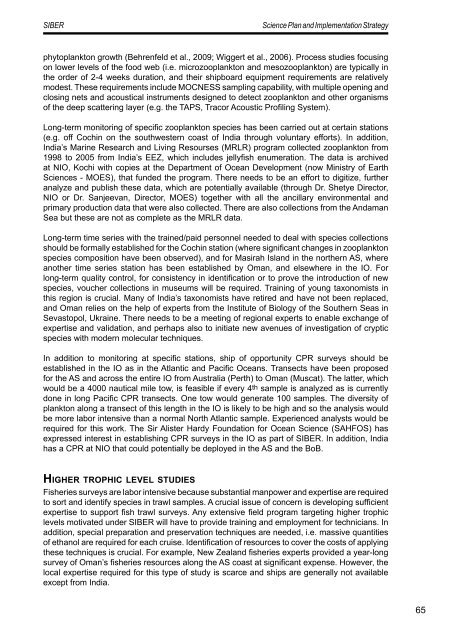SIBER SPIS sept 2011.pdf - IMBER
SIBER SPIS sept 2011.pdf - IMBER
SIBER SPIS sept 2011.pdf - IMBER
You also want an ePaper? Increase the reach of your titles
YUMPU automatically turns print PDFs into web optimized ePapers that Google loves.
<strong>SIBER</strong><br />
Science Plan and Implementation Strategy<br />
phytoplankton growth (Behrenfeld et al., 2009; Wiggert et al., 2006). Process studies focusing<br />
on lower levels of the food web (i.e. microzooplankton and mesozooplankton) are typically in<br />
the order of 2-4 weeks duration, and their shipboard equipment requirements are relatively<br />
modest. These requirements include MOCNESS sampling capability, with multiple opening and<br />
closing nets and acoustical instruments designed to detect zooplankton and other organisms<br />
of the deep scattering layer (e.g. the TAPS, Tracor Acoustic Profiling System).<br />
Long-term monitoring of specific zooplankton species has been carried out at certain stations<br />
(e.g. off Cochin on the southwestern coast of India through voluntary efforts). In addition,<br />
India’s Marine Research and Living Resourses (MRLR) program collected zooplankton from<br />
1998 to 2005 from India’s EEZ, which includes jellyfish enumeration. The data is archived<br />
at NIO, Kochi with copies at the Department of Ocean Development (now Ministry of Earth<br />
Sciences - MOES), that funded the program. There needs to be an effort to digitize, further<br />
analyze and publish these data, which are potentially available (through Dr. Shetye Director,<br />
NIO or Dr. Sanjeevan, Director, MOES) together with all the ancillary environmental and<br />
primary production data that were also collected. There are also collections from the Andaman<br />
Sea but these are not as complete as the MRLR data.<br />
Long-term time series with the trained/paid personnel needed to deal with species collections<br />
should be formally established for the Cochin station (where significant changes in zooplankton<br />
species composition have been observed), and for Masirah Island in the northern AS, where<br />
another time series station has been established by Oman, and elsewhere in the IO. For<br />
long-term quality control, for consistency in identification or to prove the introduction of new<br />
species, voucher collections in museums will be required. Training of young taxonomists in<br />
this region is crucial. Many of India’s taxonomists have retired and have not been replaced,<br />
and Oman relies on the help of experts from the Institute of Biology of the Southern Seas in<br />
Sevastopol, Ukraine. There needs to be a meeting of regional experts to enable exchange of<br />
expertise and validation, and perhaps also to initiate new avenues of investigation of cryptic<br />
species with modern molecular techniques.<br />
In addition to monitoring at specific stations, ship of opportunity CPR surveys should be<br />
established in the IO as in the Atlantic and Pacific Oceans. Transects have been proposed<br />
for the AS and across the entire IO from Australia (Perth) to Oman (Muscat). The latter, which<br />
would be a 4000 nautical mile tow, is feasible if every 4th sample is analyzed as is currently<br />
done in long Pacific CPR transects. One tow would generate 100 samples. The diversity of<br />
plankton along a transect of this length in the IO is likely to be high and so the analysis would<br />
be more labor intensive than a normal North Atlantic sample. Experienced analysts would be<br />
required for this work. The Sir Alister Hardy Foundation for Ocean Science (SAHFOS) has<br />
expressed interest in establishing CPR surveys in the IO as part of <strong>SIBER</strong>. In addition, India<br />
has a CPR at NIO that could potentially be deployed in the AS and the BoB.<br />
Hig h e r tr o p h i c le v e l st u d i e s<br />
Fisheries surveys are labor intensive because substantial manpower and expertise are required<br />
to sort and identify species in trawl samples. A crucial issue of concern is developing sufficient<br />
expertise to support fish trawl surveys. Any extensive field program targeting higher trophic<br />
levels motivated under <strong>SIBER</strong> will have to provide training and employment for technicians. In<br />
addition, special preparation and preservation techniques are needed, i.e. massive quantities<br />
of ethanol are required for each cruise. Identification of resources to cover the costs of applying<br />
these techniques is crucial. For example, New Zealand fisheries experts provided a year-long<br />
survey of Oman’s fisheries resources along the AS coast at significant expense. However, the<br />
local expertise required for this type of study is scarce and ships are generally not available<br />
except from India.<br />
65












